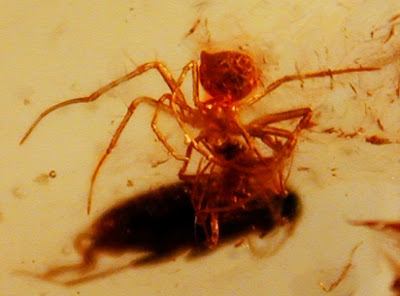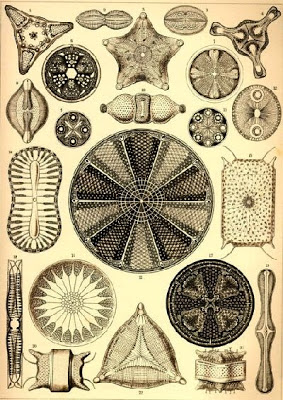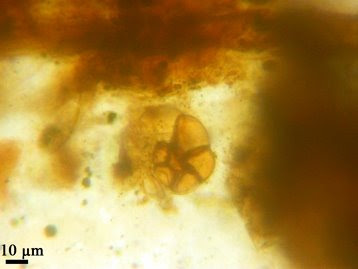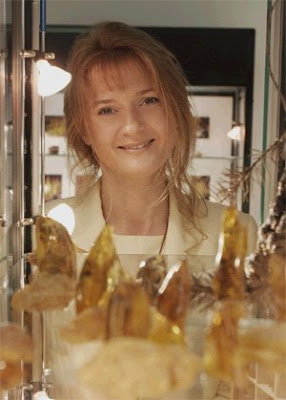Philosophy
I have been fascinated with insects permanently trapped in amber...I even had several when I had my rock and mineral collection. A wonderful sample of forest denizens trapped in tree sap and the stuff of some poetic and philosophical thoughts beyond the scientific information. I am reminded of the poetry of John Keats' "Ode on a Grecian Urn".
 Ode on a Grecian Urn
Ode on a Grecian Urn
by
John Keats
THOU still unravish'd bride of quietness,
Thou foster-child of Silence and slow Time,
Sylvan historian, who canst thus express
A flowery tale more sweetly than our rhyme:
What leaf-fringed legend haunts about thy shape
Of deities or mortals, or of both,
In Tempe or the dales of Arcady?
What men or gods are these? What maidens loth?
What mad pursuit? What struggle to escape?
What pipes and timbrels? What wild ecstasy?
Heard melodies are sweet, but those unheard
Are sweeter; therefore, ye soft pipes, play on;
Not to the sensual ear, but, more endear'd,
Pipe to the spirit ditties of no tone:
Fair youth, beneath the trees, thou canst not leave
Thy song, nor ever can those trees be bare;
Bold Lover, never, never canst thou kiss,
Though winning near the goal-yet, do not grieve;
She cannot fade, though thou hast not thy bliss,
For ever wilt thou love, and she be fair!
Ah, happy, happy boughs! that cannot shed
Your leaves, nor ever bid the Spring adieu;
And, happy melodist, unwearièd,
For ever piping songs for ever new;
More happy love! more happy, happy love!
For ever warm and still to be enjoy'd,
For ever panting, and for ever young;
All breathing human passion far above,
That leaves a heart high-sorrowful and cloy'd,
A burning forehead, and a parching tongue.
Who are these coming to the sacrifice?
To what green altar, O mysterious priest,
Lead'st thou that heifer lowing at the skies,
And all her silken flanks with garlands drest?
What little town by river or sea-shore,
Or mountain-built with peaceful citadel,
Is emptied of its folk, this pious morn?
And, little town, thy streets for evermore
Will silent be; and not a soul, to tell
Why thou art desolate, can e'er return.
O Attic shape! fair attitude! with brede
Of marble men and maidens overwrought,
With forest branches and the trodden weed;
Thou, silent form! dost tease us out of thought
As doth eternity: Cold Pastoral!
When old age shall this generation waste,
Thou shalt remain, in midst of other woe
Than ours, a friend to man, to whom thou say'st,
'Beauty is truth, truth beauty,-that is all
Ye know on earth, and all ye need to know.'
Just imagine the spider preparing to dine on a captured insect but denyed the feast much as the "bold lover" attempting a kiss from the fair maiden..."...Bold Lover, never, never canst thou kiss,/Though winning near the goal...." Nevertheless, there is a recent article from PhysOrg.com..."Marine microorganisms have been found in amber dating from the middle of the Cretaceous period. The fossils were collected in Charente, in France. This completely unexpected discovery will deepen our understanding of these lost marine species as well as providing precious data about the coastal environment of Western France during the Cretaceous." Those are the marine plankton, including diatoms.

 "Marine plankton found in amber"
"Marine plankton found in amber"
November 13th, 2008
PhysOrg.com
This work was carried out by researchers at the Géosciences Rennes laboratory (CNRS/Université de Rennes 1), together with researchers from the Paléobiodiversité et Paléoenvironnement laboratory in Paris (CNRS/Muséum national d'histoire naturelle/Université Pierre et Marie Curie) and the Centre de Géochimie de la Surface in Strasbourg (CNRS/Université de Strasbourg 1). It was published in the 11 November 2008 issue of PNAS.
Amber is a fossil resin with a reputation for preserving even the most minute details of insects and other terrestrial arthropods (spiders, scorpions, mites) that lived in resiniferous trees. The forest-based provenance of amber in theory makes it impossible for marine animals to be trapped in the resin.
Nonetheless, researchers from the Géosciences Rennes laboratory have discovered various inclusions of marine plankton in amber from the Mid-Cretaceous (100 to 98 million years BP). These micro-organisms are found in just a few pieces of amber among the thousands that have been studied, but show a remarkable diversity: unicellular algae, mainly diatoms found in large numbers, traces of animal plankton, such as radiolaria and a foraminifer, spiny skeletons of sponges and of echinoderms.
Carried out together with researchers at the Muséum national d'histoire naturelle, the study of diatoms pushed back by 10 to 30 million years the known date for the appearance of certain marine forms of this type of algae. This new information, taken together with recent data on molecular phylogeny, marks a huge advance in our understanding of the complex evolutionary history of diatoms.
The presence of these marine organisms in the amber is an ecological paradox. How did these marine species become stuck and then trapped in the conifers' resin? The most likely scenario is that the forest producing the amber was very close to the coast, potentially shrouded by plankton-bearing mist or flooded by sea water during storms.
The preservation of marine organisms in amber is an exceptional asset, allowing us to deepen our understanding of these lost species and to have a clear idea about the coastal environment of Western France during the Cretaceous.
 Elzbieta Sontag
Elzbieta Sontag
Not long ago NOVA offered a program hosted by David Attenborough entitled "Jewel of the Earth"...insects trapped in amber.
"Jewel of the Earth" [transcript]
"Jewel of the Earth"
- Comedist Commandments
Brothers, Sisters, and Transgenedered Comedists Everywhere: One of the functions of a religion is to provide spiritual guidance on living life. So on this the holiest day of the year, I give unto you these fifteen?oy?these Ten Commandments: 1. I am the...
- The Ten Commandments - Funny Decalogue Edition
If you listened to Christopher Hitchens' analysis of the Ten Commandments a few days ago, you might remember he made reference to Arthur Hugh Clough's famous swiftian Decalogue. Well, as luck would have it, it just so happens that I started reading...
- 700 New Species...from Indian Amber
"Ancient Amber Reveals 700 New Insect Species" October 26th, 2010 Science News Researchers have discovered more than 700 new species of prehistoric insects in a 50-million-year-old amber deposit in India. The 330 lb. deposit, dubbed Cambay amber, was...
- Dr. Rebecca Mcleod Takes "macdiarmid Young Scientist Of The Year Awards"
Dr. Rebecca McLeod Excellent. Like recent Kathryn Tabb [Darwin Correspondence Project (United Kingdom)] another young woman has taken the top MacDiarmid Young Scientist of the Year Awards prize in New Zealand for her research on rain forests that their...
- Knowledge Limitations
"Ode On A Grecian Urn" John Keats Thou still unravished bride of quietness, Thou foster child of silence and slow time, Sylvan historian, who canst thus express A flowery tale more sweetly than our rhyme: What leaf-fringed legend haunts about thy shape...
Philosophy
Amber's encapsulated gems
I have been fascinated with insects permanently trapped in amber...I even had several when I had my rock and mineral collection. A wonderful sample of forest denizens trapped in tree sap and the stuff of some poetic and philosophical thoughts beyond the scientific information. I am reminded of the poetry of John Keats' "Ode on a Grecian Urn".
 Ode on a Grecian Urn
Ode on a Grecian Urnby
John Keats
THOU still unravish'd bride of quietness,
Thou foster-child of Silence and slow Time,
Sylvan historian, who canst thus express
A flowery tale more sweetly than our rhyme:
What leaf-fringed legend haunts about thy shape
Of deities or mortals, or of both,
In Tempe or the dales of Arcady?
What men or gods are these? What maidens loth?
What mad pursuit? What struggle to escape?
What pipes and timbrels? What wild ecstasy?
Heard melodies are sweet, but those unheard
Are sweeter; therefore, ye soft pipes, play on;
Not to the sensual ear, but, more endear'd,
Pipe to the spirit ditties of no tone:
Fair youth, beneath the trees, thou canst not leave
Thy song, nor ever can those trees be bare;
Bold Lover, never, never canst thou kiss,
Though winning near the goal-yet, do not grieve;
She cannot fade, though thou hast not thy bliss,
For ever wilt thou love, and she be fair!
Ah, happy, happy boughs! that cannot shed
Your leaves, nor ever bid the Spring adieu;
And, happy melodist, unwearièd,
For ever piping songs for ever new;
More happy love! more happy, happy love!
For ever warm and still to be enjoy'd,
For ever panting, and for ever young;
All breathing human passion far above,
That leaves a heart high-sorrowful and cloy'd,
A burning forehead, and a parching tongue.
Who are these coming to the sacrifice?
To what green altar, O mysterious priest,
Lead'st thou that heifer lowing at the skies,
And all her silken flanks with garlands drest?
What little town by river or sea-shore,
Or mountain-built with peaceful citadel,
Is emptied of its folk, this pious morn?
And, little town, thy streets for evermore
Will silent be; and not a soul, to tell
Why thou art desolate, can e'er return.
O Attic shape! fair attitude! with brede
Of marble men and maidens overwrought,
With forest branches and the trodden weed;
Thou, silent form! dost tease us out of thought
As doth eternity: Cold Pastoral!
When old age shall this generation waste,
Thou shalt remain, in midst of other woe
Than ours, a friend to man, to whom thou say'st,
'Beauty is truth, truth beauty,-that is all
Ye know on earth, and all ye need to know.'
Just imagine the spider preparing to dine on a captured insect but denyed the feast much as the "bold lover" attempting a kiss from the fair maiden..."...Bold Lover, never, never canst thou kiss,/Though winning near the goal...." Nevertheless, there is a recent article from PhysOrg.com..."Marine microorganisms have been found in amber dating from the middle of the Cretaceous period. The fossils were collected in Charente, in France. This completely unexpected discovery will deepen our understanding of these lost marine species as well as providing precious data about the coastal environment of Western France during the Cretaceous." Those are the marine plankton, including diatoms.

 "Marine plankton found in amber"
"Marine plankton found in amber"November 13th, 2008
PhysOrg.com
This work was carried out by researchers at the Géosciences Rennes laboratory (CNRS/Université de Rennes 1), together with researchers from the Paléobiodiversité et Paléoenvironnement laboratory in Paris (CNRS/Muséum national d'histoire naturelle/Université Pierre et Marie Curie) and the Centre de Géochimie de la Surface in Strasbourg (CNRS/Université de Strasbourg 1). It was published in the 11 November 2008 issue of PNAS.
Amber is a fossil resin with a reputation for preserving even the most minute details of insects and other terrestrial arthropods (spiders, scorpions, mites) that lived in resiniferous trees. The forest-based provenance of amber in theory makes it impossible for marine animals to be trapped in the resin.
Nonetheless, researchers from the Géosciences Rennes laboratory have discovered various inclusions of marine plankton in amber from the Mid-Cretaceous (100 to 98 million years BP). These micro-organisms are found in just a few pieces of amber among the thousands that have been studied, but show a remarkable diversity: unicellular algae, mainly diatoms found in large numbers, traces of animal plankton, such as radiolaria and a foraminifer, spiny skeletons of sponges and of echinoderms.
Carried out together with researchers at the Muséum national d'histoire naturelle, the study of diatoms pushed back by 10 to 30 million years the known date for the appearance of certain marine forms of this type of algae. This new information, taken together with recent data on molecular phylogeny, marks a huge advance in our understanding of the complex evolutionary history of diatoms.
The presence of these marine organisms in the amber is an ecological paradox. How did these marine species become stuck and then trapped in the conifers' resin? The most likely scenario is that the forest producing the amber was very close to the coast, potentially shrouded by plankton-bearing mist or flooded by sea water during storms.
The preservation of marine organisms in amber is an exceptional asset, allowing us to deepen our understanding of these lost species and to have a clear idea about the coastal environment of Western France during the Cretaceous.
 Elzbieta Sontag
Elzbieta SontagNot long ago NOVA offered a program hosted by David Attenborough entitled "Jewel of the Earth"...insects trapped in amber.
"Jewel of the Earth" [transcript]
"Jewel of the Earth"
- Comedist Commandments
Brothers, Sisters, and Transgenedered Comedists Everywhere: One of the functions of a religion is to provide spiritual guidance on living life. So on this the holiest day of the year, I give unto you these fifteen?oy?these Ten Commandments: 1. I am the...
- The Ten Commandments - Funny Decalogue Edition
If you listened to Christopher Hitchens' analysis of the Ten Commandments a few days ago, you might remember he made reference to Arthur Hugh Clough's famous swiftian Decalogue. Well, as luck would have it, it just so happens that I started reading...
- 700 New Species...from Indian Amber
"Ancient Amber Reveals 700 New Insect Species" October 26th, 2010 Science News Researchers have discovered more than 700 new species of prehistoric insects in a 50-million-year-old amber deposit in India. The 330 lb. deposit, dubbed Cambay amber, was...
- Dr. Rebecca Mcleod Takes "macdiarmid Young Scientist Of The Year Awards"
Dr. Rebecca McLeod Excellent. Like recent Kathryn Tabb [Darwin Correspondence Project (United Kingdom)] another young woman has taken the top MacDiarmid Young Scientist of the Year Awards prize in New Zealand for her research on rain forests that their...
- Knowledge Limitations
"Ode On A Grecian Urn" John Keats Thou still unravished bride of quietness, Thou foster child of silence and slow time, Sylvan historian, who canst thus express A flowery tale more sweetly than our rhyme: What leaf-fringed legend haunts about thy shape...
